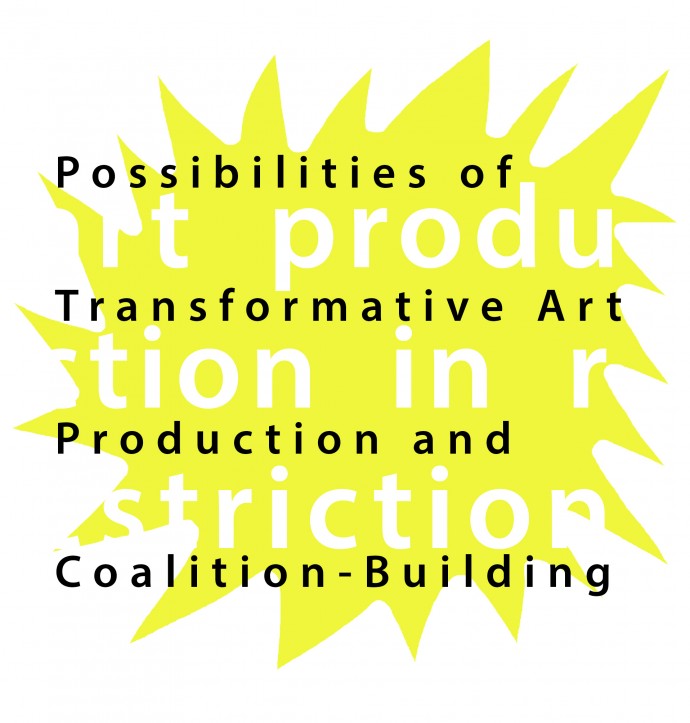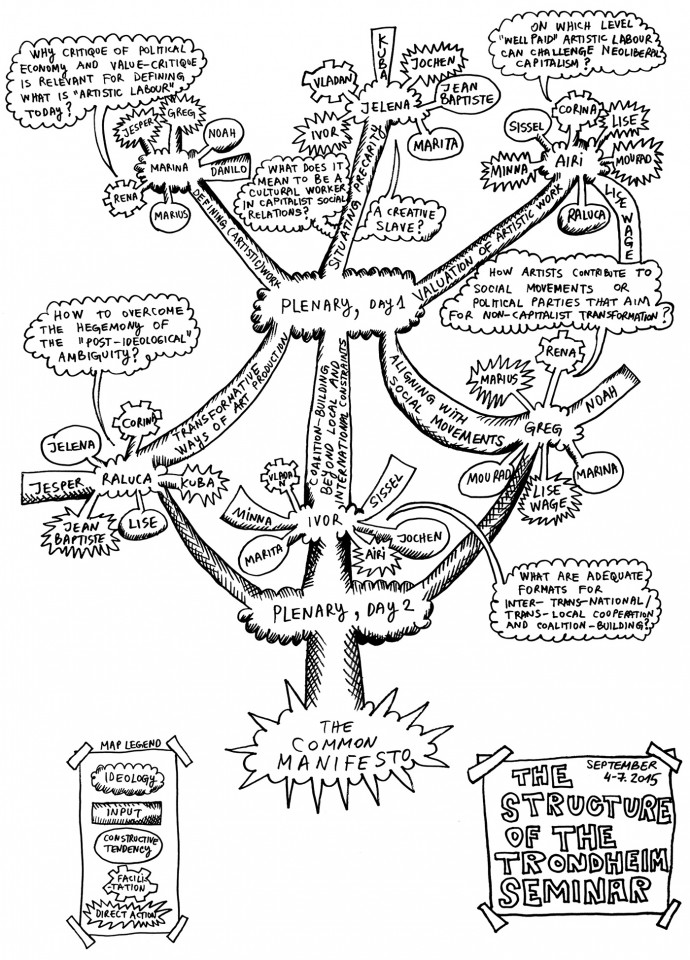Art Production in Restriction. Possibilities of Transformative Art Production and Coalition-Building
Airi Triisberg (Tallinn), Corina L Apostol (ArtLeaks, Bucharest), Danilo Prnjat (DeMaterijalizacija umetnosti, Belgrade), Gregory Sholette (New York), Ivor Stodolsky (Perpetuum Mobile, Berlin), Jean-Baptiste Naudy (Ateliers Populaires de Paris), Jelena Vesić (Belgrade), Jesper Alvær (Oslo), Jochen Becker (metroZones, Berlin), Kuba Szreder (Warsaw), Lise Skou (Aarhus), Lise Soskolne (W.A.G.E., New York), Marina Vishmidt (London), Marita Muukkonen (Perpetuum Mobile, Helsinki), Marius Lervåg Aasprong (Trondheim), Minna Henriksson (Helsinki), Mourad El Garouge (Ateliers Populaires de Paris), Noah Fischer (Occupy Museums, New York), Raluca Voinea (ArtLeaks, Bucharest), Sissel M Bergh (Trøndelag Bildende Kunstnere, Trondheim) Curators: Vladan Jeremic and Rena Raedle.

Seminar, 4-7 September 2015
Mini Book Fair, 5-6 September 2015
Nova Kino / Nova Hotell
Cicignons plass
Trondheim, Norway
Read the online compendium of the seminar transformativeartproduction.net.
Seminar
The seminar brings together artists, writers, critics, and curators who are active in groups that are struggling for better working conditions in the arts and society at large. Throughout the course of two days participants will discuss theoretical conceptions of artistic labor and precarity, exchange local and transnational experiences in confronting the neoliberal entrepreneurial mode of art production, and strategize models of transformative and emancipatory art production and organizing.
Mini Book Fair
The Mini Book Fair features publications and artists’ editions dealing with the topics of art and work. Seminar participants and artists and writers from Trondheim will present their publications to the audience.
Working hours:
Saturday, 5 September 2015, 18-20h
Sunday, 6 September 2015, 18-20h

Since the neoliberal attack on public institutions of art and art education, artistic work has become an entrepreneurial activity within a restrictive framework conditioned by the expanding art market and hegemonic political agendas prescribing the usefulness of art. The division of labor in the creative and knowledge industries has formed huge masses of artists that serve as a “reserve army” for cheap creative labor.
In recent years artists have organized themselves in new ways, developing strategies to agitate for better labor conditions and certain standards of payment for artistic work.
Major discussions dealing with the conditions of artistic production address the precarity that artistic labor has in common with other branches of “immaterial” and reproductive, or “invisible”, labor. In this context, artistic work is seen as a model for highly-exploitative working relations in late capitalism. To understand what kind of precarity is at stake one needs to take into account the whole process of production and the position of the artist within it.
Obviously, we should distinguish between the precarity of Thai berry pickers working in the forests of Finland and Norway and the position of artists that, believing in the idea of liberated work, have to labor under precarious conditions. Less obvious, but no less real, are the different levels of precarity due to the social stratification of the art world. This encompasses artists producing pieces for the art market, artists working in art management and administration, and community and non-profit-oriented art practices.
In examining these differences and contradictions, with conditions varying considerably between the peripheries and centers of capital, between the global South and North, can the general precarity of art production be seen to function as a common denominator in artists’ struggles for better working conditions? Or, do we need a different political basis for coalition-building that would be realized in a different model of production? How can this different production model support coalition-building? In such a setting, can the autonomy of artistic production become an emancipatory force, or should artists join social movements and political parties of the new left that aim for non-capitalist transformation?
Vladan Jeremic and Rena Raedle
![]()
![]()
